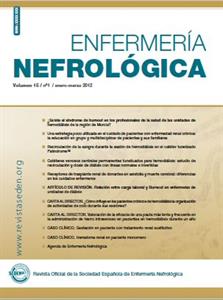Contenido del artículo principal
Resumen
La frecuencia de embarazo en mujeres sometidas a hemodiálisis es baja (entre 0,3 y 0,75% año mujeres en edad fértil)1. Este hecho se atribuye a diferentes factores hormonales, muchos de ellos anovulatorios: hiperprolactinemia, disfunción ovárica con anovulaciones, insuficiencia lútea, disminución de la libido (debido a alteraciones de los pulsos de la gonadotropina coriónica humana), niveles aumentados de leptina (por disminución de su aclaramiento renal), anormalidades del eje pituitario ovárico2. Cuando se produce un caso de embarazo en una paciente de HD, independientemente del criterio que se siga, la prescripción de la hemodiálisis debe ser suficiente para mantener estables las condiciones maternas en relación al volumen circulante, presión sanguínea (= 140/80 a 90 mm Hg 7,8,10) y la ganancia ponderal interdialítica. La prescripción de la ultrafiltración se debe individualizar para evitar episodios de hipovolemia, hipotensión arterial y arritmia cardiaca materna. Se debe ajustar para respetar la ganancia ponderal y la expansión del volumen sanguíneo materno que corresponde al tiempo de la gestación1. Los trastornos metabólicos son una de las partes más difíciles de manejar. Las concentraciones ideales de hemoglobina y de hematocrito oscilan entre 11-12 mg/dl y entre 33-36% respectivamente. Se debe mantener un control de la misma manera de calcio, fosforo y potasio.
Palabras clave
Detalles del artículo
Derechos de autor 2012 Thais Castellano Carrón

Esta obra está bajo una licencia internacional Creative Commons Atribución-NoComercial 4.0.
Aviso de derechos de autor/a
© Los autores ceden de forma no exclusiva los derechos de explotación de los trabajos publicados y consiente en que su uso y distribución se realice con la Licencia Creative Commons Atribución - No comercial 4.0 Internacional (CC BY-NC 4.0). Puede consultar desde aquí la versión informativa y el texto legal de la licencia. Esta circunstancia ha de hacerse constar expresamente de esta forma cuando sea necesario.
Referencias
- Vázquez Rodríguez, J.G “Hemodiálisis y embarazo. Aspectos técnicos.” Revistas médicas mejicanas. Ciruj. 2010 78:99-102.
- Luque Vadillo E, Matamala Gaston A, Places Balsalobre J, Alconchel Cabezas S, Torres Jansá M, Días Cocera M.“Gestación en una paciente con IRC en programa de hemodiálisis”. Rev.Soc.Esp.Enferm. Nefrol.2002; 19:47-49.
- Reece A.E., Hobbins J. Obstetricia clínica. Ed. Médica Panamericana. 3ª edición 2010.
- Pérez Escobar MM. Et. Al. Alteraciones anatomofuncionales renales en la embarazada. Rev. ginecología y obstetricia clínica. 2004. 5 (2):96-110.
- Hochatter Arduz E., Gutiérrez Flores C. Insuficiencia renal crónica y embarazo; revista médica.
- Rodríguez Fernández J.E. “Nefropatía en el embarazo” monografías.com. Cuenca (Ecuador) 2004.Pérez Santana J., Silva García L., Gómez Martínez D., Morillo Cadierno RM. “Manual para el diplomado en enfermería” módulo 1.Editorial Mad SL primera edición abril 2003: 84-6665-2267-0.
- GAN (Gastronomía+Nutrición).“¿Qué puedo comer si tengo insuficiencia renal?” Abbott Laboratories (folleto informativo) Febrero 2010.
Referencias
Vázquez Rodríguez, J.G “Hemodiálisis y embarazo. Aspectos técnicos.” Revistas médicas mejicanas. Ciruj. 2010 78:99-102.
Luque Vadillo E, Matamala Gaston A, Places Balsalobre J, Alconchel Cabezas S, Torres Jansá M, Días Cocera M.“Gestación en una paciente con IRC en programa de hemodiálisis”. Rev.Soc.Esp.Enferm. Nefrol.2002; 19:47-49.
Reece A.E., Hobbins J. Obstetricia clínica. Ed. Médica Panamericana. 3ª edición 2010.
Pérez Escobar MM. Et. Al. Alteraciones anatomofuncionales renales en la embarazada. Rev. ginecología y obstetricia clínica. 2004. 5 (2):96-110.
Hochatter Arduz E., Gutiérrez Flores C. Insuficiencia renal crónica y embarazo; revista médica.
Rodríguez Fernández J.E. “Nefropatía en el embarazo” monografías.com. Cuenca (Ecuador) 2004.Pérez Santana J., Silva García L., Gómez Martínez D., Morillo Cadierno RM. “Manual para el diplomado en enfermería” módulo 1.Editorial Mad SL primera edición abril 2003: 84-6665-2267-0.
GAN (Gastronomía+Nutrición).“¿Qué puedo comer si tengo insuficiencia renal?” Abbott Laboratories (folleto informativo) Febrero 2010.




